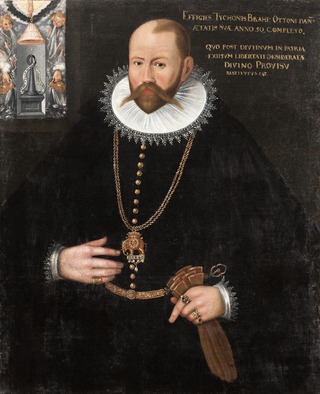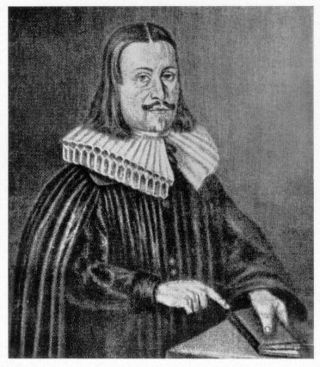Related Research Articles

The Scientific Revolution was a series of events that marked the emergence of modern science during the early modern period, when developments in mathematics, physics, astronomy, biology and chemistry transformed the views of society about nature. The Scientific Revolution took place in Europe in the second half of the Renaissance period, with the 1543 Nicolaus Copernicus publication De revolutionibus orbium coelestium often cited as its beginning.

Tycho Brahe ; born Tyge Ottesen Brahe, generally called Tycho; 14 December 1546 – 24 October 1601) was a Danish astronomer, known for his comprehensive and unprecedentedly accurate astronomical observations. He was known during his lifetime as an astronomer, astrologer, and alchemist. He was the last major astronomer before the invention of the telescope.

Uraniborg was a Danish astronomical observatory and alchemy laboratory established and operated by Tycho Brahe. It was built c. 1576 – c. 1580 on Hven, an island in the Øresund between Zealand and Scania, Sweden, which was part of Denmark at the time. It was expanded with the underground facility Stjerneborg on an adjacent site.

Ira Remsen was an American chemist who discovered the artificial sweetener saccharin along with Constantin Fahlberg. He was the second president of Johns Hopkins University.

Andreas Libavius or Andrew Libavius was born in Halle, Germany c. 1550 and died in July 1616. Libavius was a renaissance man who spent time as a professor at the University of Jena teaching history and poetry. After which he became a physician at the Gymnasium in Rothenburg and later founded the Gymnasium at Coburg. Libavius was most known for practicing alchemy and writing a book called Alchemia, one of the first chemistry textbooks ever written.

The Copernican Revolution was the paradigm shift from the Ptolemaic model of the heavens, which described the cosmos as having Earth stationary at the center of the universe, to the heliocentric model with the Sun at the center of the Solar System. This revolution consisted of two phases; the first being extremely mathematical in nature and the second phase starting in 1610 with the publication of a pamphlet by Galileo. Beginning with the publication of Nicolaus Copernicus’s De revolutionibus orbium coelestium, contributions to the “revolution” continued until finally ending with Isaac Newton’s work over a century later.

Roger Adams was an American organic chemist who developed the eponymous Adams' catalyst, and helped determine the composition of natural substances such as complex vegetable oils and plant alkaloids. He isolated and identified CBD in 1940. As head of the Chemistry department at the University of Illinois from 1926 to 1954, he influenced graduate education in America, taught over 250 Ph.D. students and postgraduate students, and served in military science during World War I and World War II.
Albert Lester Lehninger was an American biochemist in the field of bioenergetics. He made fundamental contributions to the current understanding of metabolism at a molecular level. In 1948, he discovered, with Eugene P. Kennedy, that mitochondria are the site of oxidative phosphorylation in eukaryotes, which ushered in the modern study of energy transduction. He is the author of a number of classic texts, including: Biochemistry, The Mitochondrion, Bioenergetics and, most notably, his series Principles of Biochemistry. This last is a widely used text for introductory biochemistry courses at the college and university levels.
Gilbert Stork was an organic chemist. For a quarter of a century he was the Eugene Higgins Professor of Chemistry Emeritus at Columbia University. He is known for making significant contributions to the total synthesis of natural products, including a lifelong fascination with the synthesis of quinine. In so doing he also made a number of contributions to mechanistic understanding of reactions, and performed pioneering work on enamine chemistry, leading to development of the Stork enamine alkylation. It is believed he was responsible for the first planned stereocontrolled synthesis as well as the first natural product to be synthesised with high stereoselectivity.

Sophia or Sophie Brahe or after marriage Sophie Thott Lange, was a Danish noblewoman and horticulturalist with knowledge of astronomy, chemistry, and medicine. She worked alongside her brother Tycho Brahe in making astronomical observations.
James Riddick Partington was a British chemist and historian of chemistry who published multiple books and articles in scientific magazines. His most famous works were An Advanced Treatise on Physical Chemistry and A History of Chemistry, for which he received the Dexter Award and the George Sarton Medal.

In the history of science, pneumatic chemistry is an area of scientific research of the seventeenth, eighteenth, and early nineteenth centuries. Important goals of this work were the understanding of the physical properties of gases and how they relate to chemical reactions and, ultimately, the composition of matter. The rise of phlogiston theory, and its replacement by a new theory after the discovery of oxygen as a gaseous component of the Earth atmosphere and a chemical reagent participating in the combustion reactions, were addressed in the era of pneumatic chemistry.
The HIST Award for Outstanding Achievement in the History of Chemistry (2013–present) is given by the Division of the History of Chemistry of the American Chemical Society (ACS). The award was originally known as the Dexter Award (1956–2001) and then briefly as the Sidney M. Edelstein Award (2002–2009), both given by the ACS.
Robert Russell Newton was an American physicist, astronomer, and historian of science.
Harmon Northrop Morse was an American chemist. Today he is known as the first to have synthesized paracetamol, but this substance only became widely used as a drug decades after Morse's death. In the first half of the 20th century he was best known for his study of osmotic pressure, for which he was awarded the Avogadro Medal in 1916. The Morse equation for estimating osmotic pressure is named after him.

Oswald Croll or Crollius was an alchemist, and professor of medicine at the University of Marburg in Hesse, Germany. A strong proponent of alchemy and using chemistry in medicine, he was heavily involved in writing books and influencing thinkers of his day towards viewing chemistry and alchemy as two separate fields.
Samuel Colville Lind was a radiation chemist, referred to as "the father of modern radiation chemistry".

Kenneth D. Karlin was born on October 30, 1948, in Pasadena, California, a professor of chemistry at Johns Hopkins University in Baltimore, Maryland. Research in his group focuses on coordination chemistry relevant to biological and environmental processes, involving copper or heme complexes. Of particular interest are reactivities of such complexes with nitrogen oxides, O2, and the oxidation of substrates by the resultant compounds. He is also the Editor-in-Chief of the book series Progress in Inorganic Chemistry.
Edward I. Solomon is the Monroe E. Spaght Professor of Chemistry at Stanford University. He is an elected member of the United States National Academy of Sciences, a Fellow of the American Association for the Advancement of Science, and a Fellow of the American Academy of Arts and Sciences. He has been profiled in the Proceedings of the National Academy of Sciences. He has also been a longtime collaborator with many scientists, including Professor Kenneth D. Karlin at Johns Hopkins University.
Robert P. Multhauf (1919–2004) was an American science historian, curator, director, scientific scholar and author. He served as president of the History of Science Society in the year 1979-80, and was awarded the Leonardo da Vinci Medal in 1987.
References
- 1 2 "Owen Hannaway, 66, Hopkins professor of science history". 28 January 2006.
- 1 2 "Owen Hannaway (1939–2006)" (PDF). Retrieved 14 January 2017.
- ↑ "Edelstein Fellowship". Science History Institute . Retrieved 27 March 2018.
- ↑ Hall, Marie Boas (March 1977). "Review of The Chemists and the Word: The Didactic Origins of Chemistry by Owen Hannaway". Isis. 68 (1): 152–153. doi:10.1086/351753.